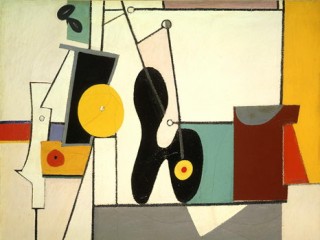
Arshile Gorky biography
Date of birth : 1904-04-15
Date of death : 1948-07-21
Birthplace : Khorgom, Vilayet of Van, Ottoman Empire
Nationality : Armenian-American
Category : Famous Figures
Last modified : 2010-12-15
Credited as : Artist painter, ,
The American painter Arshile Gorky (1905-1948) created a personal language of form dealing with the iconography of the unconscious that enabled him to extend surrealism in the 20th century.
Born in Turkish Armenia, Vosdanig Manoog Adoian changed his name in 1925 to Arshile Gorky, meaning the "bitter one." He emigrated to the United States with his sister at the age of 15. After studying briefly at the Rhode Island School of Design, he moved to Boston in 1923, where he secured part-time work. He continued his studies at the New School of Design, where he was engaged as instructor in 1924. The following year Gorky moved to New York City, where for the next 6 years he was on the faculty of the Grand Central School of Design. In this period Gorky's work drew on a variety of sources, including Camille Corot, J. A. D. Ingres, and Pablo Picasso.
The key work of Gorky's early period is the Artist and His Mother (ca. 1926-1929), a double portrait composed of cool flowing shapes which evokes a mood of stillness. Although this portrait is reserved in terms of its painterly qualities, relying heavily on the fine flowing line of Ingres, Gorky was simultaneously exploring the colorspace synthesis of Paul Cezanne (Staten Island, 1927/1928) and the surrealist-inspired figurative phase of Picasso (Still Life, 1929). This latter interest, in surrealist biomorphic shape, Gorky mastered and extended during the next 2 decades.
Gorky's work during the 1930s was divided between drawing and painting. The rather geometrical Organization Series (1933-1936) was probably a result of the artist's awareness of the work of Josef Albers. Gorky's Aviation mural (a Federal Art Project commission now lost), the theme of which was repeated in the Aviation murals for the 1939 New York World's Fair, broke away from the more enclosed forms of the Organization Series and exploited photomontage and cubist pictorial space. As public art, Gorky's murals make no attempt to create an easy visual experience for the layman.
Toward the end of the 1930s, as Gorky came under the influence of the work of Andre Masson, his work seemed to depend less on explicit references verifiable to the spectator and more on a felt memory expressed in his developing, vibrant palette. The Image of Xhorkhom (ca. 1936) exists in four versions and, like the numerous versions of his Garden in Sochi (1938-1940), ostensibly refers by its title to the remembrance of things past. The latter series is a development from the former, with the images grown more delicate and cleaner in shape, the surfaces less densely painted, and the legibility of the artist's forms increasingly ambiguous as Gorky achieved a complete metamorphosis of floral and anatomical imagery.
Gorky's last years witnessed a further extension of surrealist devices, stimulated by the presence in America of Roberto Matta Echaurren and later by the arrival of the remaining coterie of surrealists headed by Andre Breton. Gorky's application of paint achieved a greater freedom, the resulting images shining through the thin pigment, as in the Pirate I (1942). His palette increased in intensity, and great puffs of florescent color seemed to vibrate from The Liver Is the Cock's Comb (1944). But during the same period Gorky could turn to the arabesque line of Ingres and the delicate hues found in his Good Afternoon, Mrs. Lincoln (1944). In the works of the last 2 years of his life, of which Agony (1947) and Betrothal II (1947) are exemplary, Gorky successfully achieved the visual metaphors of felt new experience. He committed suicide on July 21, 1948.
Harold Rosenberg, Arshile Gorky: The Man, the Time, the Idea (1962), is a valuable critical interpretation of Gorky and his paintings but the illustrations are poor. One of the most important critical studies of Gorky is Ethel K. Schwabacher, Arshile Gorky (1957), which contains biographical and bibliographical information. For a study of Gorky's work with excellent illustrations see Julien Levy, Arshile Gorky (1966), which includes a study of the artist's last years by a close friend.



















